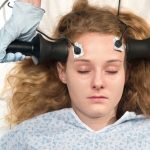 The use of electric current with anesthetics and muscle relaxants to induce convulsive seizures. It is most effective in the treatment of depression. It was introduced in 1938 by italian psychiatrists UGO cerletti (1877–1963) and lucio bini (1908–1964). The american psychiatric association task force on ECT (2000) found ECT useful for the treatment of major depression, mania or bipolar disorder, schizophrenia with catatonia or prominent affective symptomatology, schizophreniform disorder, and schizoaffective disorder. Modifications are electronarcosis, which produces sleep-like states, and electrostimulation, which avoids convulsions.
The use of electric current with anesthetics and muscle relaxants to induce convulsive seizures. It is most effective in the treatment of depression. It was introduced in 1938 by italian psychiatrists UGO cerletti (1877–1963) and lucio bini (1908–1964). The american psychiatric association task force on ECT (2000) found ECT useful for the treatment of major depression, mania or bipolar disorder, schizophrenia with catatonia or prominent affective symptomatology, schizophreniform disorder, and schizoaffective disorder. Modifications are electronarcosis, which produces sleep-like states, and electrostimulation, which avoids convulsions.
Administration of electric current to the brain through electrodes placed on the head to induce seizure activity in the brain, used in the treatment of certain mental disorders, especially severe depression.
The treatment of severe depression and some mental disorders by giving someone who has been anaesthetised small electric shocks in the brain to make him or her have convulsions.
Treatment for certain mental disorders, especially severe depression, in which a brief convulsion is induced by passing an electric current through the brain. The patient is placed in a comfortable supine position, and a state of general anesthesia induced. Electrodes are placed on both sides of the forehead, and an electric current is delivered for a very brief time (less than one- half second). The patient then experiences involuntary muscle contractions (convulsions) for a short period and awakens with no memory of the shock. Electroconvulsive therapy is now less commonly used than it once was, having been largely replaced by psychoactive drags. Also called electroshock therapy; shock therapy.
Use of electrical current and electrodes on the head to produce seizures while sedated; alters the brain chemistry to treat severe depression more rapidly than antidepressant drugs.
A treatment in which electrical shocks are given to a person with a mental disease such as depression, who has not responded to medication or psychotherapy.
A treatment for severe depression and occasionally for schizophrenia and mania. A convulsion is produced by passing an electric current through the brain, The convulsion is modified by giving a muscle relaxant drug and an anesthetic, so that in fact only a few muscle twitches are produced. The means by which ECT acts is not yet known. The procedure can also produce confusion, loss of memory, and headache, which almost always pass off within a few hours. These side-effects are reduced by unilateral treatment, in which the current is passed only through the nondominant hemisphere of the brain.
The process of administering brief, carefully measured electrical current, through electrodes attached to the head, to alter the brain’s electrical activity. The patient is first given an anesthetic and a muscle relaxant. ECT is used to treat certain mental disorders, including depression. Today’s ECT is far safer than early applications of the technology. Also known as “shock therapy” or “electroshock therapy.”
A controversial but sometimes rapidly effective treatment for cases of severe depression, particularly where psychotic features are present, or in high-risk patients such as suicidal or post-partum patients. ECT is only indicated after antidepressants have been tried and shown to be ineffective; the full procedure of treatment should be explained to the patient, whose consent must be obtained.
The use of an electric shock to produce convulsions and thereby treat drug-resistant or especially severe psychiatric disorders (e.g., major depression, bipolar disorder, suicidal ideation, and schizophrenia).
Inducing convulsions by means of electric shock; also known as “electric shock therapy.”
This form of therapeutic intervention is employed for the treatment of profound depression and severe mental disorders that demonstrate resistance to pharmaceutical remedies. A precisely measured quantum of electrical energy is introduced into the cerebral region to induce a convulsive state. Electroconvulsive therapy, proven to be both secure and efficacious, offers significant benefits.
ECT stands for Electroconvulsive Therapy, a treatment primarily employed for severe depression cases. While its usage has decreased over time due to the introduction of newer and more effective antidepressant drugs, ECT still remains a valuable option. The procedure often provides faster relief from depression compared to medications and can be a life-saving measure for individuals with severe depression that is unresponsive to other forms of treatment.
During this treatment, an electric current is applied to the brain, deliberately causing a seizure. ECT is conducted with the patient under a brief general anesthetic and accompanied by a muscle-relaxant drug to minimize the physical impact of the induced seizure. Typically, the treatment is scheduled once or twice a week, and the entire course spans six weeks. It’s worth noting that temporary amnesia (memory loss) is a potential side effect of this procedure.
